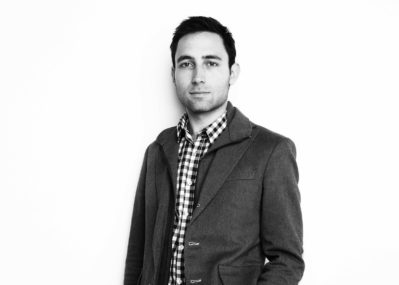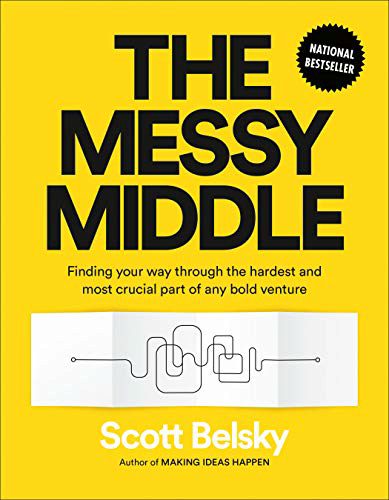As startup companies grow past their initial stages, moving towards a finished product or venture can be a long, arduous process, often with no certain end in sight. In this episode of Mastering Innovation on SiriusXM Channel 132, Business Radio Powered by The Wharton School, Scott Belsky, author of The Messy Middle, elaborates on the struggles that developing businesses have in their middle stages and how to get past them.
When telling the story of their company, many successful entrepreneurs focus on the beginning and the end of their project or venture. But in every business, there is a middle period of growth, uncertainty, and perseverance that a team must endure to reach their goal. Frustrated by the tendency to overlook this important phase, Belsky set out to describe the volatility that businesses must endure and how to optimize an organization’s team, resources, and decision-making to get through its awkward adolescence. He emphasizes the importance of good leadership and the building of a versatile and diverse team that will stick through the highs and the lows of starting a business.
Transcript

Harbir Singh: What are the most common mistakes entrepreneurs make during the final mile with their companies?
Scott Belsky: The final mile is a different sport altogether. There are key things that get you through the volatility of a journey: getting the team to endure the lows, making sure you optimize the way your team works, the way that you make decisions, and the way that your product works. Then suddenly towards the finish, whether it’s a launch of a product, an acquisition, a bankruptcy, the launch of a book, or whatever your project is, there are a lot of interesting things that start to happen.
First, there is some sort of self-sabotage. People aren’t ready to be done. Subconsciously, they might feel like, “Well, we shouldn’t do this,” or, “Maybe I should change everything at the last minute.” There is a lot of last-minute churn that even the best product teams endure. There’s also the question of identity: “Am I my work? I’ve been working on this for 7 to 10 years and now I’m going to have to part with it? Who am I after that transaction is done?” A lot of things happen towards the end of a journey.
Singh: That brings us to “the messy middle,” the part before the final mile. What’s the difference between endurance and slogging through?
Belsky: If you think about when you’re in the middle of a bold venture, whether it’s a product turnaround at a big company or a startup, you are working in relative anonymity. No one knows or really cares about what you’re doing. You’re not contributing anything to quarterly results. Not yet. You don’t have any revenue or customers yet. This uncertainty, anxiety, and constant ambiguity really goes against our natural human tendency, which is always needing to have a short-term reward. We’re governed by short-term rewards and gratification. The average life expectancy in the 17th century was 26 years old or something like that. The idea of spending 10 years to achieve something is arguably unfathomable from a biological perspective.
The middle and endurance is really about short-circuiting your reward system or that of your team to stick with something long enough to figure it out. That’s one of the competitive advantages of successful startups that people don’t talk about: it’s a team that sticks together long enough to figure it out and apply some new technology or techniques to an old industry.
Singh: Is this partly the motivation for writing this book — reminding people that it is about execution, about plowing through the complexities of building the next generation model and dealing with prototypes that may not work? That it’s not just having cool ideas, getting an investment, delivering the product, and getting a great exit?
“That’s one of the competitive advantages of successful startups that people don’t talk about: it’s a team that sticks together long enough to figure it out and apply some new technology or techniques to an old industry.” – Scott Belsky
Belsky: Like most products and projects that I commit myself to, this book is inspired by frustration with how much we love talking about the starts and finishes of things, frustration with the fact that when famous entrepreneurs and CEOs talk about their experiences, they skip over all of this middle volatility that frankly they’d probably rather forget. I felt like there needed to be some texture applied to what people are doing in the middle. What can we learn from how teams are enduring? What are the tactics for optimizing in those middle periods of a product in a team and a company? What is the role of diversity for innovation in a team, and what are other things you have to factor into this middle volatility in order to come up with an extraordinary outcome?

Singh: Tell us more about diversity and its impact on innovation.
Belsky: What is innovation? Everyone has a different opinion and answer. To me, in short, it’s the edges that will someday become the center. It’s those edges, those things at the edge of reason, that people might say we should immediately discount because they’re too much at the edge of reality right now. Yet those are the things that — through timing, market forces, or other factors — suddenly could become the center in the future.
The question then from an innovation perspective is, how do you stack the deck in your favor as a team to give those edges more of a chance of getting the focus and energy? To me, the way to stack the deck in your favor is to hire an extraordinarily different group of extraordinary people who just think about things differently. How do you do that? The key is to find people with different backgrounds, people who look differently, speak differently, and therefore may have a slightly better chance of getting excited about an edge that you would otherwise discount. It’s one of the first steps you take in building a team that’s set up well for innovation.
Singh: Fascinating. What I find interesting about what you’re saying is that this also applies to larger organizations. In fact, I teach courses on innovation. I also consult in this area for larger companies. One of the dilemmas many leaders have is their inability to predict or anticipate group dynamics. That’s what you’re talking about here, isn’t it?
“The key is to find people with different backgrounds, people who look differently, speak differently, and therefore may have a slightly better chance of getting excited about an edge that you would otherwise discount.” – Scott Belsky
Belsky: In the venture capital world, it’s common knowledge that conviction is more powerful than consensus. It’s easy to say, but how do you achieve that? How do you have an instance where everyone is not thinking the same way? If you all went to the same school and all worked together in the past at the same types of companies, there likely is “common knowledge” that everyone subscribes to.
As a result there is seldom going to be an opportunity where one person says, “Wait, I see something that no one else does, and I feel so much conviction,” that everyone else just lets go of their disbelief and says, “I have so much respect for you that your conviction will outweigh the rest of our consensus. We should do it.” There’s a group dynamic that makes it more likely for these edges to get the spotlight, and then also a group dynamic where people are respected so much that conviction can in fact outweigh consensus.
About Our Guest
Scott Belsky is an executive, entrepreneur, author, and investor (and all-around product obsessive). He currently serves as Adobe’s Chief Product Officer and Executive Vice President, Creative Cloud. Scott’s passion is to make the creative world more productive, connected, and adaptive to new technologies. Scott co-founded Behance in 2006, and served as CEO until Adobe acquired Behance in 2012. Millions of people use Behance to display their portfolios, as well as track and find top talent across the creative industries. After Behance’s acquisition, Scott helped reboot Adobe’s mobile product strategy and led Behance until 2016, when he spent a few years as an investor and advisor to multiple businesses. Alongside his role at Adobe, Scott is a Venture Partner at Benchmark – a venture capital firm based in San Francisco, an early-stage investor, and is co-founder and Executive Chairman of Prefer, a referrals platform that empowers the careers of independent professionals (aka “Soloists”).
Over the years, Scott has pursued other projects to help organize and empower the careers of creative people. These include 99U, Behance’s think tank and annual conference devoted to execution in the creative world; and a popular line of organizational paper products that help organize creative people and teams. He attended Cornell University as an undergraduate and received his MBA from Harvard Business School. Scott and his family live in New York City and San Francisco.
Mastering Innovation is live on Thursdays at 4:00 p.m. ET. Listen to more episodes here.



